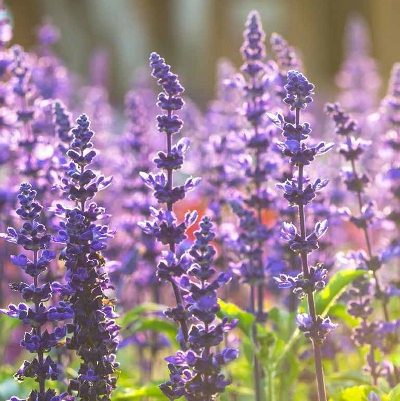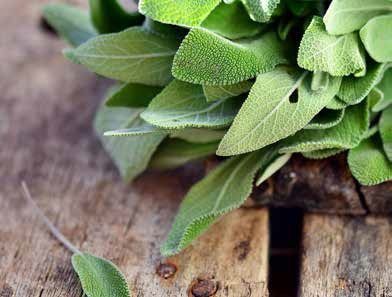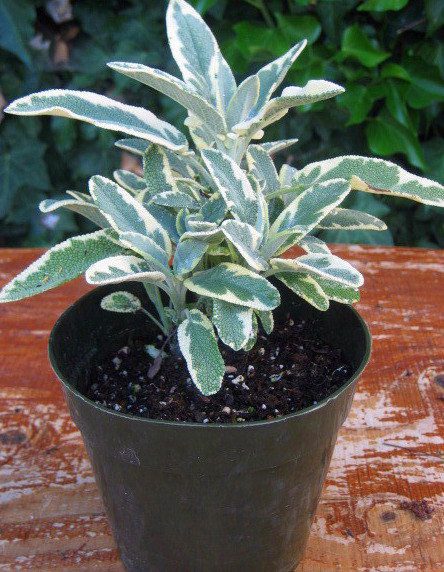HISTORY & FOLKLORE
A word with two meanings, sage the noun refers to a herb with culinary and medicinal uses, and sage the adjective describes a wise and experienced person. Since one benefit of the Salvia plant has long been said to sharpen one’s mental prowess, sage being a synonym of wisdom cannot be a coincidence.
The word salvia comes from ancient Greek that literally means ‘to save’, or the Latin counterpart for ‘well being’. Compared to other herbs, sage is a bit bland, not in flavor or benefits, but it lacks wild myth, and folklore. Man has just always known that sage was savvy. All cultures believed it safe, beneficial, a source of improved intelligence, and the key to a long life.
Don’t confuse it with the wide variety of ornamental Salvia cultivars, herbal sage has been used for healing since the days of ancient China. In Rome of old, it was also used to infuse food and drink with flavor, and assisting meal digestion. The Arabs believed that one
could not die if sage was prospering under your care. Charlemagne wanted it grown everywhere. In Middle Age England, it was said to only grow well where the wife was in charge, but was as must-have as salt and pepper in Colonial America.
HEALTH BENEFITS
 While of Mediterranean origin, traditional Chinese medicine has used sage tea to soothe sore throats and indigestion since 835 A.D. It is still used for digestive and cough home remedies worldwide. Sage tincture can be used to soothe gum pain and treat gingivitis.
While of Mediterranean origin, traditional Chinese medicine has used sage tea to soothe sore throats and indigestion since 835 A.D. It is still used for digestive and cough home remedies worldwide. Sage tincture can be used to soothe gum pain and treat gingivitis.
The many powerful active constituents in sage give us essential oils, minerals, along with disease-preventing, and health-promoting vitamins. A natural antioxidant, disinfectant, and deodorizer that is anti-inflammatory, anti-allergic, anti-fungal, and anti-hemorrhagic.
It’s also been used for hundreds of years to lighten menstrual flow, slow wound bleeding, treat menopausal hot flashes, increase fertility, and dry up breast milk. This isn’t folklore, they’ve discovered that sage contains natural estrogens. Pregnant women should avoid sage tea and essential oils, though it’s perfectly safe to eat as a seasoning. Two recent UK studies found that a 50 mL dosage of essential oil significantly increased short-term memory in young adults, proving its value for increasing mental acuity is factual. Aside from preventing ‘senior moments’, sage is also part of natural anti-aging beauty regimens. The Gypsies swore by it for darkening graying hair – just one more cosmetic benefit.
NOMENCLATURE
There are over 900 Salvia species on Earth, but only 80 are in cultivation, and very few have culinary or healing uses. Store-bought dried or rubbed sage is stronger than garden sage, both because it’s dehydrated, and because of the cultivar, which is Greek Sage or Dalmatian Sage (S. triloba syn. S. fruticosa).
Retailed dried sage’s intensity, and the common overseasoning of holiday stuffing gives a lot of people the idea that this isn’t a herb for regular cooking. Learn how to use it, and discover what you’ve been missing. The colorful flowers are edible too.
- Common Garden Sage (Salvia officinalis) – Much milder, and more palatable than other culinary sages. All variants of S. officinalis are hardy perennials to zone 5, and similar tasting, though variegated selections are a bit milder. This is the form most commonly used for healing throughout Europe and Asia.
- Golden Garden Sage (S. o. icterina) – Low growing with green and gold variegated leaves.
- Purple Garden Sage (S. o. purpurea) – Deep purple new growth matures to soft green.
- Tricolor Garden Sage (S. o. tricolor) – Marbled pink, cream, and green variegation.
- Berggarten Sage (S. o. Berggarten) – Large leaves perfect for garnishing. It rarely blooms.
- Dwarf Garden Sage (S. o. minum) – The best one for container growing.
- Pineapple Sage (Salvia elegans) – Sweeter than the rest. Best used in desserts, meat glazes and marinades, with fruit, and in drinks. Larger red flowers that are also edible. Native of Mexico. Hardy to zone 8. (syn. S. rutilans)
- Chia (Salvia hispanica) – Yes, of Chia Pet fame. Native Americans, both Aztec and Apache, ate this while hunting and traveling. Seed from this plant retails for £6-40 ($7-48) a pound, because it’s very high in Omega-3 fatty acids, and the richest vegetable source of alpha-linolenic acid (ALA). Native of Mexico and Guatemala. Hardy to zone 9.
- Grape-Scented Sage (Salvia melissodora) – The leaves and seeds have been used for healing for thousands of years. Native to Mexico, hardy to zone 9.
SAGE GROWING NOTES
With good drainage, it’s very easy to grow this herb outdoors, providing you have a spot in full sun. It’s also easy to grow indoors, making winter fresh sage possible, given ample light. While these types of salvia can reach .6-1.8 meters tall, depending on the species grown, you
can keep plants at 30-45 cm high with regular harvesting. Most sage plants produce well for three years, and are evergreen in the right climate. Growing indoors will allow you to enjoy not just fresh winter herbs, but also the more tender sages from South America.
Common insect problems are mites and, and like many plants that prefer sharp drainage, sage can be prone to fungal infections. While the infection can harm and dwarf the plant, most of the time it does not kill sage. Give it the conditions it thrives in for a more efficient harvest, and trouble-free crop.
GERMINATION
It’s easily grown from seed, but stored seed offers only 50% germination at best. Cuttings root reliably, and starting new plants from cuttings is extremely common. Make sure the mother plant is pest and disease-free. Quarantine cuttings before moving into a grow room.
Start seeds with both the room and propagation mat at 21°C. Expect seed germination in 7-10 days. You can use rockwool cubes, or coarse seed starting mix.
Transplant seedlings at 5 cm tall to your finishing system or containers after 4-5 weeks in winter, and 1-2 weeks in summer. Humidity isn’t critical for this plant, though excellent drainage is. Space them 15 cm apart in your hydro system.
OUTDOOR CONDITIONS
It’s not difficult to learn how to grow sage outdoors, as long as the soil is well-draining. It dislikes clay and lots of overhead water – from rain and the hose. Be sure the spot gets at least 6-8 hours of full sun, and give it lots of air flow too. In poor draining soil and over-crowded growing conditions, sage, like many herb plants, can develop root and leaf diseases. Amend clay soil to greatly improve your soil drainage.
INDOOR ENVIRONMENT
For rooting and vegetative growth you want day temps of 24-29°C, and nights ranging from 16-26°C. You can grow it in all types of hydro systems, in aquaponics, with drip irrigation, and traditional hand-watered container culture. When grown in potting mix, let the top inch of soil dry out before watering.
GROWTH MEDIA
The plants are natives of light, sandy soils, so wherever you grow it be sure to give its roots a similar home. Use a coarse potting soil with extra perlite. It does well in just about any hydroponic medium.
LIGHTING
In the outdoor garden, this plant needs about 8 hours of full sun. A sunny window is not enough light on its own. You need supplemental lighting. Use a compact fluorescent grow light. Keep in mind that an hour of direct outdoor sun requires 2 hours of grow light exposure as an equivalent.
Inside a grow room, or in situations where there is little to no sun at all, you need a minimum of 12 hours under lights. Less light than that, and you’ll wonder if it’s growing at all.
For optimum growth and harvesting times provide 700 footcandles with 14 hour days. Less light equals slower growth, and a less efficient crop. Don’t count on sage flowers when growing indoors, unless you’re running intense HIDs.
NUTRIENTS
Standard vegetative nutrients or organic fertilizer is fine. There are no special nutritional needs.
HARVEST
Given the conditions described above, expect the first summer harvest after transplanting in 4-5 weeks, and 5-7 weeks in winter. You get multiple harvests if your plants are robust, since sages are perennials and subshrubs.
Greenhouse yields in an NFT system are: 1.8 kg per 3 meters of trough in summer, and .45 kg per 4.5 meters of trough in winter. Under good grow lighting indoors you’ll get a little heavier harvest in winter, and less in summer than the full sun conditions in a greenhouse would produce.
 By the way, this is a rather uncommon fresh-cut herb in retail selections, at least in the United States, and may present small growers with a great market crop, especially during the winter holiday season.
By the way, this is a rather uncommon fresh-cut herb in retail selections, at least in the United States, and may present small growers with a great market crop, especially during the winter holiday season.
CULINARY USES
There are a surprising number of ways to use fresh sage, so if you thought this was all about poultry stuffing and sausages, it’s time to expand your cuisine horizons. While the flavor of just-cut sage leaves are milder than dried or frozen, the blue flowers are subtler still. They make a lovely edible garnish and salad ingredient, seasoned butter, simple syrup, and are great with dried beans, corn, and mushrooms.
How much milder? A lot – substitute 5 ml of fresh for every 1 ml of dry sage any recipe calls for. It combines well with bay, caraway, cutting celery, dried ginger, lovage, marjoram, paprika, parsley, savory, and thyme.
Use your sage harvest for flavoring winter squash and meats: veal, turkey, chicken, pork, and fish. It is good in stews, stuffings, chowders and soups, marinades, omelets, casseroles, sauces, and gravies. It can at times be a star ingredient, like in Saltimbocca, where the fried leaves are both garnish and seasoning. Once you’ve tried fried sage leaves, you might find that they have uses that include snacking.
It pairs well with dairy, as in England’s traditional Sage Derby cheese, where it’s also enjoyed with sautéed onions. Germans use it to flavor beer, as well as sausages. Italy uses it in lots of things besides Saltimbocca. Do some culinary research online where you’ll find it combined with a wide array of foods. You’ll soon be awash in new ways to work sage into meals.
